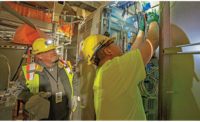Sequencing
Gate divided the job into three sections: the tower, the atrium and the plinth. The 70,000-sq-ft tower required 350 panels, averaging 8 ft tall by 28 ft long with alternating 20-degree sloped ends. The 27,000-sq-ft plinth features 220 curved, canted, radiused panels, ranging from 8 ft by 28 ft to 2 ft by 6 ft, that snake around the perimeter of the structure.
The atrium exterior is made up of 100 complex 10-ft-by-10-ft panels. About 90% of the plinth and atrium panels had a radius. Gwin considered the geometry in the atrium to be the most challenging to fabricate.
In the atrium, “there is a transition panel at Level 3 where its radius and the top half goes off in the opposite direction of the bottom half,” says Tony DiBella, Gate's project designer, adding that some plinth panels were canted and contained a radius. “This resulted in what looks like a twisted panel; however, the top and bottom hold horizontal to the world,” he says.
Each module features a 1/8-in.-by-1/8-in., rounded, protruding outline for aesthetics. The outline had to track correctly on each panel and from panel to panel as the elevation went skyward. “One would think that you couldn't see such a small line from very far away,” says Todd Petty, operations vice president for Gate in Hillsboro, Texas. “However, one glance at any elevation on the Perot Museum, and this would be disproven.”
Fabrication
Gate fabricated the panels in its Hillsboro-based plant. The company created about a dozen molds. Those modules could be moved around to create a different appearance on each panel. Standardizing helped bring the cost and production time down, Emerson says.
To be cost effective, Gate needed to do repetitive pours, which led to the module concept, Wolfe adds. “They make a rubber mold, maybe 1 ft tall by 2 ft long, and put 108 of them in one panel. Then they reconfigure from floor to floor. The outline of the panel remains the same; some of the modules change, and they have a new look when they cast the next panel.”
Some of the lower, more profile-laden panels had up to 130 different modules, Petty says. The panels are caulked between modules and the caulking provides some additional texture.






Post a comment to this article
Report Abusive Comment